Evers Calls for $500 Million Corrections Overhaul
Including closing Green Bay Prison, turning Waupun prison into 'vocational village.'
The Green Bay Correctional Institution would be closed and the Waupun Correctional Institution converted into a new “vocational village” to train incarcerated people for jobs under a set of “sweeping reforms” Gov. Tony Evers will propose in his new budget.
Evers and Department of Corrections Secretary Jared Hoy described the plan as a “domino series” of changes to facilities across the state, with each step contingent on the others. They called it the safest, quickest and least expensive way to address overcrowding and safety concerns inside prisons while reducing recidivism.
“We can address long-term staffing challenges, expand treatment and workforce training, implement evidence-based practices that reduce recidivism and save taxpayer dollars, all while, most importantly, improving public safety,” Evers told reporters during a briefing at the state Capitol.
The expansive plan, estimated to cost just under a half-billion dollars, likely faces an uphill battle with Republican lawmakers, many of whom have argued for the construction of a new prison in Green Bay to solve problems of overcrowding.
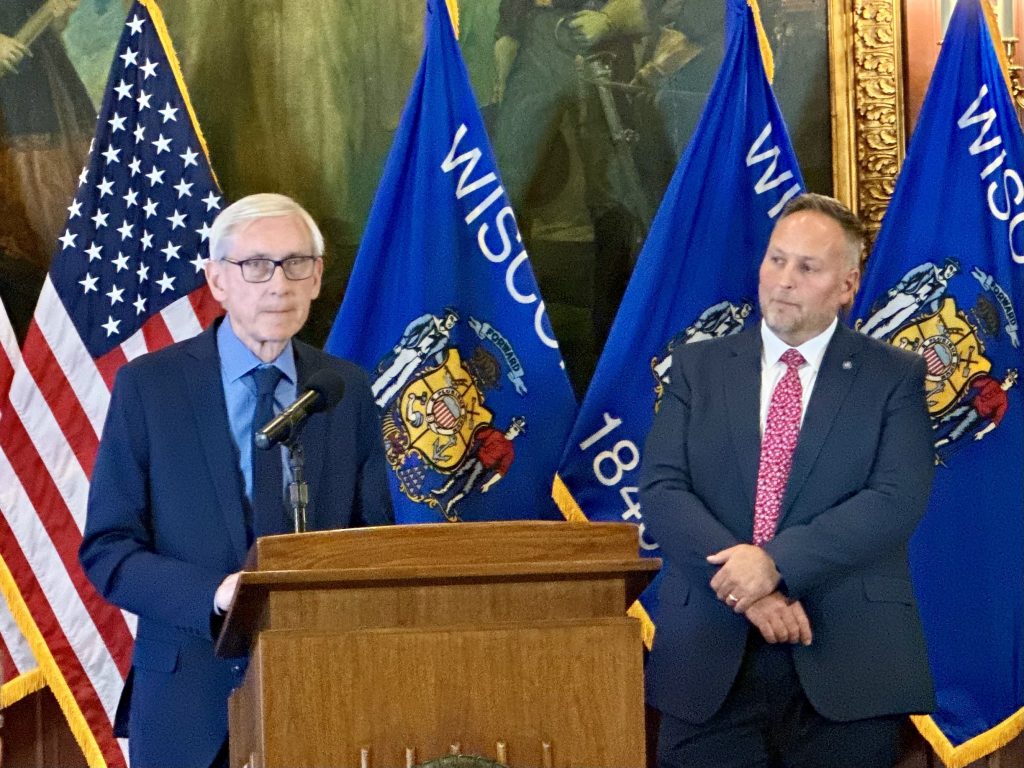
Gov. Tony Evers, left, and Wisconsin Secretary of Corrections Jared Hoy, right, unveil a proposal to shutter the Green Bay Correctional Institution and implement sweeping changes across Wisconsin’s corrections system at a press conference at the state Capitol in Madison, Wis. Anya van Wagtendonk/WPR
And the announcement comes after years of problems at Waupun, including a felony investigation into deaths at the maximum-security facility, and as efforts to close the notorious Lincoln Hills juvenile complex have stalled seven years after the state Legislature voted to close it down.
The plan will require GOP approval to go anywhere, as Republicans hold majorities in both chambers of the Legislature and will write the final budget themselves in the Joint Finance Committee.
Hoy described Evers’ proposal as supportive of both corrections staff and taxpayer dollars.
“Essentially, this effort comes down to safety,” Hoy said. “Both in our institutions and in our communities.”
A ‘domino series’ of facility changes
The complex and interwoven proposal would see most construction proposals launch around 2027, beginning a years-long process of moving incarcerated people between facilities.
It’s contingent on moving juvenile offenders out of Lincoln Hills, a troubled facility that has been slated for closure for years, and it would end with the closure of Green Bay Correctional Institution, with a rejiggering of other prisons that would reduce the overall capacity of the system by about 700.
“In order for my plan to work, several crucial steps must happen, and they must happen together,” Evers said. “All these steps are interconnected, so this plan is contingent upon each of these steps happening in concert. They must happen in tandem.”
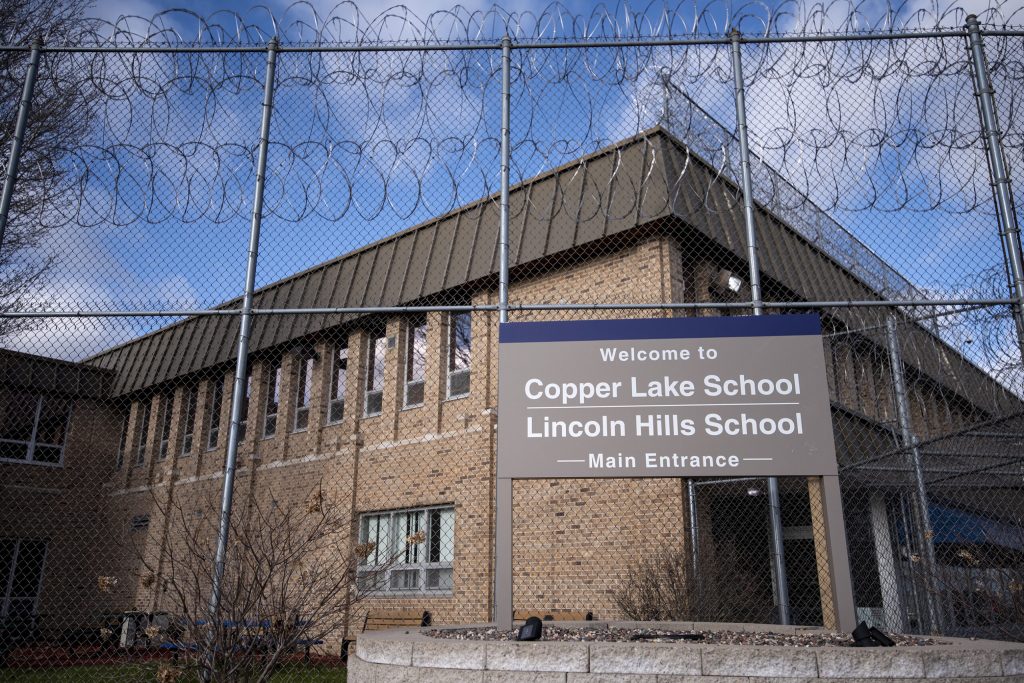
A fence surrounds Wisconsin’s Lincoln Hills youth prison Thursday, April 15, 2021, in Irma, Wis. Angela Major/WPR
The Lincoln Hills and Copper Lake juvenile facilities would be converted into a 500-bed, medium security men’s facility at a cost of about $9 million. The state would also construct a new juvenile facility in Dane County for $130.7 million to absorb the rest of that population, “and get our kids closer to home as soon as we safely and responsibly can,” Evers said.
The most expensive part of Evers’ plan calls for putting $245.3 million toward transforming the Waupun facility — which has become synonymous with the state’s corrections troubles, including severe staff shortages and recent inmate deaths — into a medium-security “vocational village,” which would offer workforce training.
That’s “one of the most exciting pieces of the plan, and it makes me smile,” said Hoy.
He said the plan would involve demolishing the housing unit at the 174-year-old building and replacing it with new housing and job training facilities. Hoy said incarcerated people would learn trades or receive technical training, earn certificates and partner with outside employers.
“While the vocational village concept is new to Wisconsin … it is not new in corrections,” Hoy said. “This concept has been successful in other states.”
Hoy argued that programs like these reduce recidivism and could transition people into Wisconsin’s skilled labor workforce, which faces its own shortages.
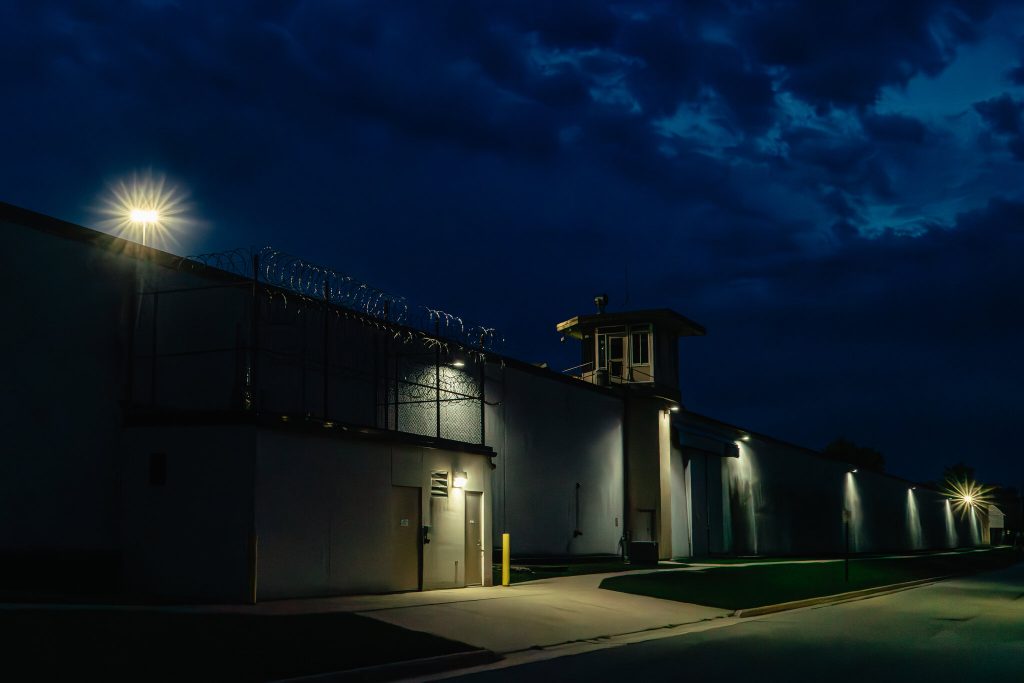
Waupun Correctional Institution in southeast Wisconsin has become synonymous with the state’s corrections troubles, including severe staff shortages and inmate deaths. Photo taken Aug. 6, 2023. Jamie Kelter Davis for The New York Times
Each of those dominoes would eventually lead to the closure of Green Bay Correctional Institution by 2029, Evers said, at a decommissioning cost of $6.3 million.
Staff at GBCI would be guaranteed work at “different correctional facilities or other appropriate positions in their field without having to be rehired,” Hoy said.
“These are not an either/or situation,” Evers said. “These steps are each a … crucial part of this comprehensive plan, and they have to happen together. And we need Republican lawmakers to get onboard with the plan.”
Evers is also requesting about $9.6 million for pay increases for corrections workers, $3.7 million for social workers and treatment specialists and $28.1 million for related programming, including staff for the newly proposed job training, recovery coaches and community-based reentry programs.
That puts the total price tag of the ask, including costs for adult and juvenile facilities, at just over $535 million.
Evers argues earned release, substance treatment will prevent recidivism
The plan would also allow people incarcerated on nonviolent charges with less than four years left in their sentence to earn earlier release through job training or substance use treatment.
Currently, people incarcerated in Wisconsin can earn early release if they are serving for a nonviolent crime and have completed substance use treatment and similar programs. This proposal would expand eligibility for completing job training, as well.
Evers’ staff estimates that would move about 2,500 people out of the system over two years, “ultimately saving taxpayers about $40,000 per person every year,” Evers said.
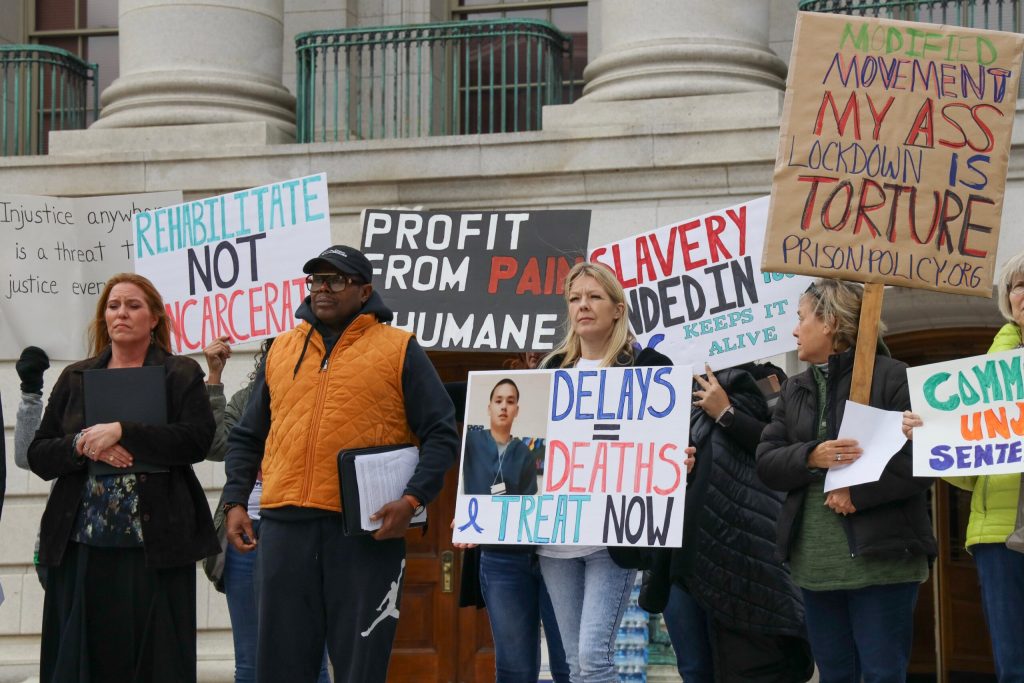
Protesters call on the short-staffed Wisconsin Department of Corrections to improve prisoner conditions and lift restrictions on prisoners’ movement during a protest at the Wisconsin State Capitol on Oct. 10, 2023, in Madison, Wis. Meryl Hubbard/Wisconsin Watch
Wisconsin has a higher-than-average incarceration rate, and one of the largest corrections budgets in the nation, according to theWisconsin Policy Forum.
Evers and Hoy argued that addressing those issues while a person is incarcerated is one way of preventing them from returning to prison.
“Our work to prevent people from reoffending must start long before they ever leave our correctional institutions,” Evers said.
Editor’s note: This story will be updated.
Evers calls for closing Green Bay prison in $535M corrections overhaul was originally published by Wisconsin Public Radio.
If you think stories like this are important, become a member of Urban Milwaukee and help support real, independent journalism. Plus you get some cool added benefits.


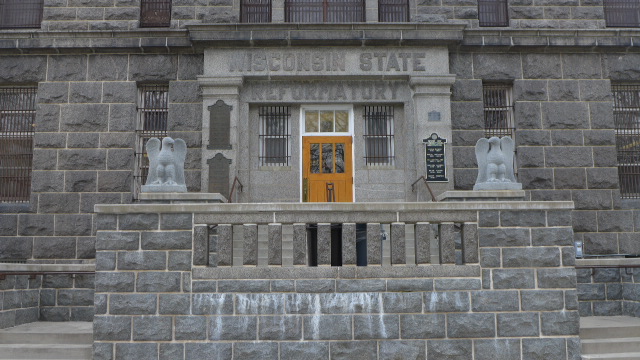



















Focusing on rehabilitation through vocational skilling is something everyone should be able to get behind.
We have the highest incarceration rate of blacks in the country. This doesn’t make us safer, but it sure makes a lot of people meaner.
Incarcerating POC also is a very effective, but also very expensive for taxpayers, form of voter suppression. Rehabilitation, for what in many cases are bad choices in a difficult position in life, makes infinitely more sense than warehousing human beings and further destroying their lives. Additionally many of the incarcerated upon completion of their sentences are released and instructed on how to apply for and attain SSI or SSDI, certainly not a win for themselves or society.